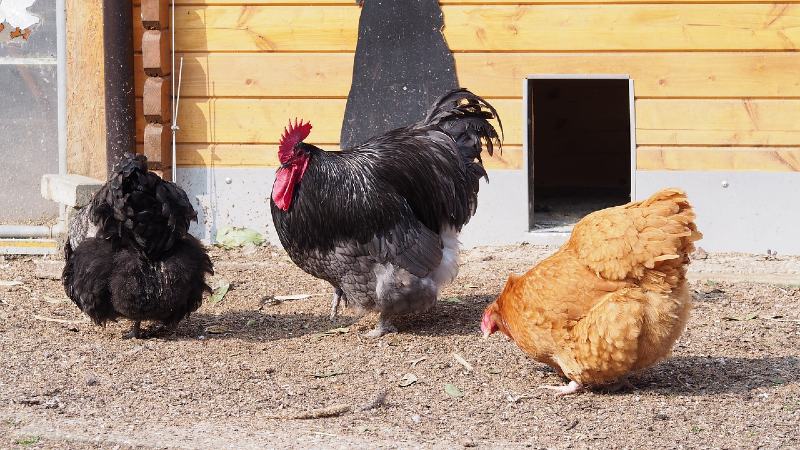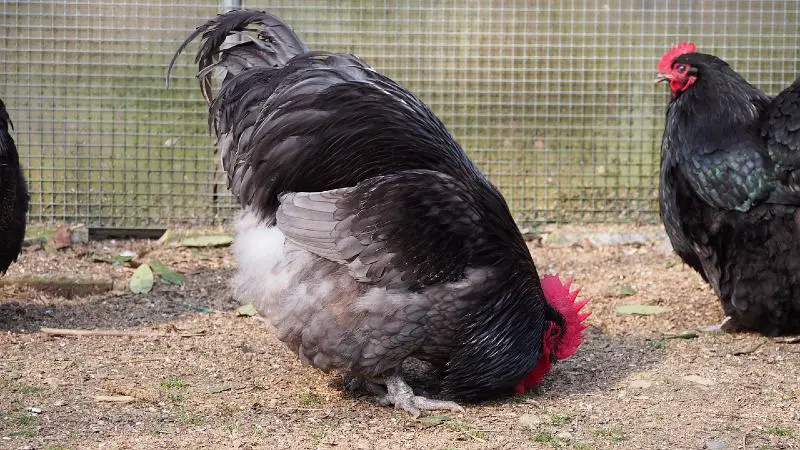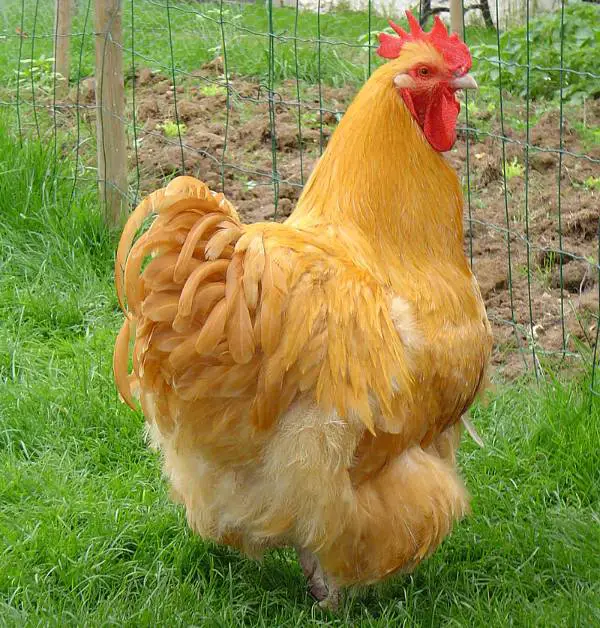The Orpington chicken originates in the United Kingdom. While it is a chicken designed to be raised for both eggs and meat production, there is a surprising amount of history behind the color. They come in a few solid color varieties, black Orpington being the first, then the white and later the buff, of which Buff Orpington is the most common.

Orpington Chicken at a Glance
| Eggs | 175 – 200 (per year) |
| Egg Color | Brown |
| Use | Eggs + Meat (dual purpose) |
| Skin Color | White |
| Comb Type | Single Comb |
| Weight | Male: 10 lb (4.55 kg) Female: 8 lb (3.60 kg) |
| Temperament | Docile |
| Broody | Yes |
| Foraging | Good |
| Country of origin | United Kingdom |
Where Do Orpington Chicken Come From?
The Orpington chicken was developed by William Cook in Orpington. You may be interested to know that William Cook also developed the Orpington Duck.
The Orpington chicken is a mixture of these breeds:
- Minorcas
- Plymouth Rocks
- Langshans
The chicken was bred to be high in both eggs and meat production.
The earliest chickens were also bred to be black in color. The black Orpington chicken was introduced in 1886.
This is because they were also meant to be a ‘show’ chicken and, as a result, you didn’t want the color of the chicken to change.
This was important, because the UK was at the height of the industrial revolution, and there was all sorts of dust and soot floating through the air. It would easily get stuck to the feathers of chickens and other bird.
By being black, it would still get stuck, but you wouldn’t realize it had stuck to the animal.
Three years after the black, the white was introduced in 1889, and the buff Orpington in 1894. A late introduction, the Jubilee Orpington, is now rarely seen.
For a good part of this century, the Orpington chicken has been regarded as an ‘endangered’ chicken, but it seems there has been a rise in the number of people picking up the Orpington to raise in their backyards as of late.
Are Orpington chickens good for backyards?
Yes, the Orpington is an excellent choice for backyards as the hens are gentle and more relaxed compared to other breeds. The relaxed nature make them excellent to roam free in your backyard for part of the day.
Do You Want Big Beautiful Eggs?
Then you must check this ORGANIC & NON-GMO feed. Our hens lay jumbo eggs now and they love this feed! You can check it right here on Amazon.
The Look of the Orpington Chicken

When we are talking about the Orpington Chicken, we are talking about the original, not the ‘buff Orpington’ version that has become very popular in recent years.
The original chicken is on the heavy side. A good few kilograms. This is due to the intention of the chicken eventually being on the table. They are quite low in their stance.
Their backs are also quite short. They will have slightly fluffy feathers which have the result of making the chicken look larger than it actually is. Even though this is one of the largest chicken breeds in the world.
Their skin is white, as are their beaks. The Orpington chicken comb should have five points and should be a bright red in color.
What are the advantages of raising Buff Orpington chickens?
They are a calm and easy to handle chicken breed.
They are great egg layers and can produce 200-300 brown eggs per year.
Great hens make fantastic mothers (broodiness)
Very tolerant to colder climates as they have very dense feathers with lots of insulation to keep bodies warm.
Orpington Chickens Colors
According to the American Poultry Association there are four recognized varieties of Orpington chicken colors:
- Black
- Blue
- Buff
- White
Orpington Chicken Eggs and Meat Production

The Orpington chicken is a dual-production bird. This means that if you raise one, you are going to be getting a decent number of eggs and some meat at the end of the day.
Of course, it is a ‘jack of all trades and master of none’, so if you do want a chicken that borders on the egg-laying side because you do not want to slaughter the bird later on, then the Orpington is not going to be the right chicken for you.
To be honest, the current breeds of Orpington are not great at egg-laying. Well, not as good as they were in the past.
You are going to be getting 4 eggs out of them per week, at the absolute maximum. That is around 175 – 200 eggs per year.
This is, partly, down to the fact that the Orpington chicken has become more of a show chicken.
As breeders worked on developing the look of the Orpington, egg production tailed off. If you had an original Orpington, then you could be getting six eggs a week from one. Nowadays, they just struggle to come even close to that.
The positive side is that the Orpington is productive throughout the year. The only time that they are going to deviate from their egg-laying schedule is when they are molting. They can produce eggs during the winter months. They are quite a cold hardy chicken breed.
Orpington Chicken Temperament

The Orpington Chicken is a very friendly chicken. Most of the time, they are going to be calm and docile. The only time the Orpington ever tends to ‘overreact’ is when they spot some awesome food that they want to eat. Other than that you are going to have a fairly calm chicken.
Some people do claim that the Orpington is a little bit on the needy side, and this is something that we can agree with. They do love attention, and they aren’t going to leave you alone at certain times!
Are Orpington chickens suitable for beginners?
Yes, Orpingtons are an excellent choice for beginners to chickens due to their friendly nature and ease of care. They adapt well to various environments and are generally less prone to health issues. They can also be raised in your home backyard as they are more calm compared to other chicken breeds.
Health Issues
There are very few health issues with the Orpington. However, you do need to be aware that the Orpington has feathers that border on the thicker side of things. This means that they are not going to dry out easily.
If your chicken gets wet, then you are going to need to physically dry the chicken on your own. If you do not do this, then your chicken has a big chance of getting sick and dying.
During the rainier days, you will probably want to keep them locked up in the coop as a result.
Overall, they would do it better in cooler climates due to their large body size, but can acclimate to warmer regions.
Feeding and Nutrition for Orpington Chickens
Proper feeding and nutrition are essential for the health and well-being of your Orpington chickens. These birds have specific dietary needs that must be met in order for them to thrive. A balanced diet consisting of high-quality chicken feed, fresh fruits and vegetables, and access to clean water is crucial. It’s also important to provide them with appropriate supplements, such as calcium for strong eggshells. Additionally, be mindful of portion sizes and avoid overfeeding, as this can lead to obesity and other health issues. By ensuring that your Orpington chickens are receiving the proper nutrition, you can help them live long, healthy lives.
Comparing Orpington Chickens to Other Breeds: A Comprehensive Analysis
When it comes to selecting the perfect chicken breed for your farm or backyard flock, a plethora of options awaits. Each breed brings its own unique set of characteristics, from egg-laying prowess to meat production and temperament. In this comprehensive comparison, we’ll delve into how Orpington chickens stack up against other popular breeds, highlighting their strengths, weaknesses, and distinct qualities.
Orpington vs. Rhode Island Red
Egg Production: Orpingtons are moderate egg layers, producing around 175 to 200 brown eggs per year, whereas Rhode Island Reds are more prolific, yielding approximately 200 to 300 brown eggs annually.
Meat Quality: Orpingtons and Rhode Island Reds are both well-regarded for their meat quality, with plump bodies and flavorful meat. The preference may lean towards personal taste, but both breeds make excellent choices for meat production.
Temperament: Orpingtons are known for their calm and friendly nature, making them easy to handle. Rhode Island Reds are active and independent, which can be ideal for free-ranging environments.
Cold Tolerance: Orpingtons have dense feathering that makes them cold-hardy, allowing them to withstand colder temperatures. Rhode Island Reds are also quite hardy but may require a bit more shelter during harsh winters.
Orpington vs. Leghorn
Egg Production: Leghorns are prolific egg layers, producing up to 280 to 320 white eggs per year, surpassing the egg-laying capabilities of Orpingtons.
Meat Quality: Orpingtons are superior in meat quality compared to Leghorns, which are generally not preferred for meat production due to their leaner bodies.
Temperament: Orpingtons have a gentle and friendly temperament, while Leghorns are known for their active and sometimes skittish behavior.
Cold Tolerance: Orpingtons excel in cold climates due to their thick feathering, whereas Leghorns are more suited for warmer environments.
Orpington vs. Plymouth Rock
Egg Production: Both Orpingtons and Plymouth Rocks fall within a similar egg-laying range, with Orpingtons laying around 175 to 200 eggs annually, and Plymouth Rocks producing about 200 to 280 brown eggs per year.
Meat Quality: Both breeds have commendable meat quality, with Orpingtons having a slightly larger frame.
Temperament: Orpingtons are known for their docile and friendly nature, whereas Plymouth Rocks exhibit a calm and easygoing temperament.
Cold Tolerance: Both breeds are cold-hardy, with Orpingtons possibly having a slight edge due to their dense feathering.
Orpington vs. Sussex
Egg Production: Sussex chickens are good egg layers, producing around 250 to 280 brown eggs per year, surpassing Orpingtons in egg yield.
Meat Quality: Orpingtons have a substantial size and good meat-to-bone ratio, making them favorable for meat production. Sussex chickens are also valued for their meat quality.
Temperament: Orpingtons are gentle and sociable, whereas Sussex chickens have a calm and adaptable demeanor.
Cold Tolerance: Both breeds are cold-hardy, with Orpingtons often being chosen for their ability to thrive in colder climates.
Orpington vs. Wyandotte
Egg Production: Wyandottes produce around 200 to 280 brown eggs per year, similar to Orpingtons.
Meat Quality: Both breeds have favorable meat qualities, with Orpingtons having a larger size.
Temperament: Orpingtons are known for their friendly nature, while Wyandottes are generally calm and docile.
Cold Tolerance: Both breeds are cold-hardy, making them suitable for colder regions.
In summary, Orpington chickens offer a balanced combination of egg production, meat quality, and temperament. While they might not excel in any one specific area, their versatility and gentle demeanor make them a popular choice for backyard flocks and small farms. Depending on your priorities and preferences, other breeds may offer more specialization in certain aspects, such as egg production or meat yield. Ultimately, the choice of breed depends on your specific goals and the unique characteristics that align with your farming or homesteading needs.
Orpington Chicken Egg Production
When it comes to egg production, the Orpington chicken holds its own among various other popular breeds. While it might not be the most prolific egg layer, its well-rounded attributes and gentle temperament contribute to its overall appeal. Let’s compare the Orpington chicken’s egg production to that of a few other notable breeds:
Orpington vs. Leghorn:
Orpington: The Orpington chicken typically produces around 175 to 200 brown eggs per year. While it may not reach the high egg-laying numbers of some other breeds, its dual-purpose nature and friendly disposition make up for it.
Leghorn: In contrast, Leghorn chickens are known for their exceptional egg-laying capabilities, yielding up to 280 to 320 white eggs per year. Leghorns are ideal for those primarily seeking high egg production.
Orpington vs. Rhode Island Red:
Orpington: Orpingtons are moderate egg layers, offering approximately 175 to 200 brown eggs annually. Their balanced attributes make them popular for both egg and meat production.
Rhode Island Red: Rhode Island Reds are known for their dual-purpose qualities as well. They produce around 200 to 300 brown eggs per year, slightly outpacing Orpingtons in egg yield while still providing good meat quality.
Orpington vs. Sussex:
Orpington: The Orpington chicken’s egg-laying capacity remains consistent, with an output of about 175 to 200 brown eggs per year. Their adaptable and gentle nature makes them a favorite among backyard keepers.
Sussex: Sussex chickens are strong egg producers, offering around 250 to 280 brown eggs annually. Their commendable egg-laying abilities and calm demeanor make them a versatile choice.
Orpington vs. Plymouth Rock:
Orpington: Orpingtons continue to deliver a dependable egg production of approximately 175 to 200 brown eggs per year. Their friendly disposition and cold-hardy nature contribute to their popularity.
Plymouth Rock: Plymouth Rock chickens, like Orpingtons, lay about 200 to 280 brown eggs per year. Both breeds strike a balance between egg production and meat quality.
Orpington vs. Wyandotte:
Orpington: With an egg-laying capacity of approximately 175 to 200 brown eggs per year, Orpingtons offer a steady supply of eggs. Their size and temperament make them versatile additions to various flocks.
Wyandotte: Wyandottes produce around 200 to 280 brown eggs annually. Their distinct appearance and cold-hardy traits contribute to their popularity.
In summary, while the Orpington chicken might not be the most prolific egg layer among breeds like Leghorns or Sussex, its attributes extend beyond egg production alone. The Orpington’s gentle temperament, substantial size, meat quality, and consistent egg yield make it a well-rounded choice for those seeking a versatile breed that excels in both egg and meat production. It’s important to consider your specific farming goals and preferences when selecting the ideal breed for your flock.
Was this response better or worse?BetterWorseSame
Final Thoughts
The Orpington chicken, for all its historical significance and practical benefits, faced a period of decline. For a considerable portion of the century, the breed teetered on the brink of endangerment, its once-vibrant presence dimmed by changing agricultural dynamics. However, the recent resurgence in interest surrounding poultry farming, particularly in backyard settings, has breathed new life into the Orpington breed.
As more individuals seek sustainable and rewarding experiences through raising chickens, the Orpington has emerged as a favored choice. Its dual-purpose attributes, coupled with its historical significance and captivating aesthetics, make it an ideal candidate for modern chicken keepers. The breed’s ability to thrive in varying climates and its gentle disposition contribute to its appeal as a friendly and productive addition to backyard flocks.
In conclusion, the Orpington chicken stands as a testament to the artistry of selective breeding and the ever-evolving relationship between humans and livestock. From its inception as a dual-purpose marvel, through its color-evolving journey, to its contemporary revival, the Orpington breed showcases the enduring connection between practicality, aesthetics, and adaptability in the world of poultry. As more enthusiasts embrace the joys of chicken keeping, the Orpington’s legacy continues to unfold, intertwining its past with the present and promising a vibrant future in the rich tapestry of agricultural heritage.
Related article: Buff Orpington chicken growth rate chart



Pingback: Top 12 Best Show Chickens (With Pictures) - ChickenMag
Pingback: Top 10 Best Meat Chickens | Raising Chickens For Meat - ChickenMag